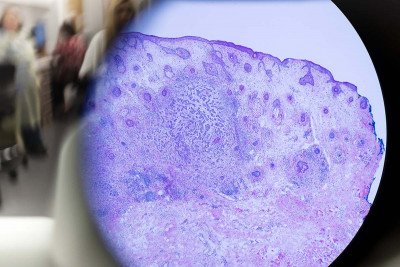
An infiltrative basal cell carcinoma under the microscope. This type of basal cell often occurs on the face. MSK's Mohs surgeons are experts in treatment option for facial skin cancers.
You know your skin best, so it makes sense that you would notice any changes before anyone else. Most suspected skin cancers are first noticed by patients or their family members.
In order to determine if you have skin cancer, your doctor will take a complete medical history, which includes asking you about:
- your past exposure to the sun
- any exposure to other known causes of skin cancer
- your personal or family history of skin conditions
- when you first noticed the mark
- if the mark has changed at all in size or appearance
Your doctor will also do a skin examination and may check for enlarged lymph nodes.
If your doctor thinks that a particular patch of skin should be checked further, you’ll likely have a biopsy, which is usually done in the doctor’s office, with a local anesthetic.
In a biopsy, all or part of the spot or growth is removed, and the tissue sample is sent to a laboratory, where a pathologist (a specialist who examines the tissue for signs of cancer) examines it. If cancer is found, your doctor will discuss with you the different options and recommendations for basal cell carcinoma treatment, based on the cancer’s features.
Basal Cell Carcinoma: High Risk and Low Risk

Mohs surgeon Erica Lee researches ways to improve quality of life in people with skin cancer.
When any type of cancer is diagnosed, it’s classified according to certain characteristics. Basal cell carcinomas are classified based on the risk of recurrence (the likelihood of it coming back after treatment), which depends mostly on where the tumor is located.
Basal cell carcinomas are considered to be high risk (likely to come back after treatment) if:
- they are located in the middle or central part of the face, such as the eyelids, nose, ears, and lips
- they have come back after first treatment
- they are wider than 2 centimeters
Basal cell carcinomas are considered to be a low risk for coming back if:
- they are small and superficial (limited to the upper level of the skin, where they originated)
- they have a clear, defined edge
- they haven’t been treated before
We’re available 24 hours a day, 7 days a week

